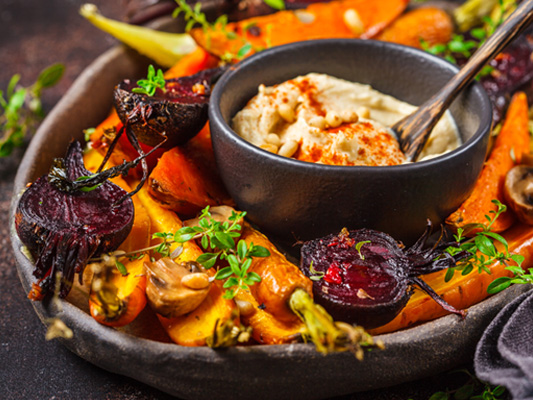Dispelling Myths About Mindful Eating
If you’ve landed here, chances are you’re curious about mindful eating, or perhaps you’ve already dipped your fork into this delicious concept. But let’s be honest, there are a few myths floating around that might have you scratching your head and wondering if mindful eating is more fiction than fact.
Sometimes, people get the wrong idea about what mindful eating is all about. Some think it’s a kind of diet, some assume that it is as simple as focusing on a single task, like munching on their lunch without distractions or strolling through life at a leisurely pace. And there are more…
So, let’s sort through and clear up a few myths and misconceptions about mindful eating here:
👻 Myth 1: Mindful eating is a diet.
✅ Reality: Hold on to your forks, folks, because mindful eating is definitely not a diet! Forget about restrictive plans, rule books, or counting calories. Mindful eating is all about being present and fully engaged in the tasty experience of eating. We’re talking about tuning into your body’s hunger and fullness signals, delighting in the flavors, textures, and aromas of your food, and being aware of the emotions and thoughts that pop up during your meal.
Instead of boxing yourself into a corner with food restrictions or sticking to rigid guidelines, mindful eating is like a breath of fresh air – it’s flexible and all about you! By helping you connect with your body’s unique needs and preferences, it paves the way for more intentional and satisfying food choices.
So, it feels good to toss away the guilt and deprivation that often come with dieting and embrace a more balanced and enjoyable approach to filling your plate and nourishing your body. Cheers to that!
👻 Myth 2: Mindful eating is only for people with eating disorders.
✅ Reality: Let’s bust this myth wide open! While mindful eating can indeed be a game-changer for those battling eating disorders, it doesn’t stop there. Mindful eating has the potential to benefit anyone looking to improve their relationship with food.
Whether you’re a busy parent juggling mealtimes, a student stress-eating during exams, or simply someone curious about exploring new ways to savor your meals, mindful eating can provide valuable insights. It’s all about helping people from all walks of life better understand their eating habits, manage emotional eating, and develop a more balanced and enjoyable approach to mealtime.
So, whether you’re personally touched by an eating disorder or simply looking to enhance your relationship with food, keep in mind that mindful eating is a practice built on compassion, awareness, and self-care. It’s an invitation for everyone to explore and cultivate a more mindful, satisfying, and nourishing approach to eating. It feels good to rediscover the joy of eating and nurturing our bodies. 💞
👻 Myth 3: Mindful eating means you have to eat slowly all the time.
✅ Reality: Let me just say it right off the bat: It’s not just about how fast or slow you’re going; it’s all about your mental state while you’re doing these things. Are you genuinely in the moment, or is your mind wandering off to la-la land? That’s the real deal here!
While slowing down can be an essential aspect of mindful eating, the practice is not solely about the pace of eating. It’s more about paying attention to the whole eating experience, which can include the flavors, textures, and emotions associated with the meal. Slowing down can help facilitate this awareness, but the key is to be present and engaged with the act of eating, regardless of the speed.
Yes, sure thing; as we start adding some mindfulness magic into our daily lives, it’s a good idea to hit the brakes a little and focus on one task at a time. When it comes to mindful eating, there are two key ingredients: slowing down and ditching those distractions. As we get better at being in the moment, we’ll find that we can be both mindful and super-efficient. In fact, when we’re moving quickly, like when we’re channeling our inner MasterChef and chopping veggies at lightning speed, we’ve got to be even more focused to keep our fingers safe!
👻 Myth 4: Mindful eating is only for certain types of food.
✅ Reality: Mindful eating can be practiced with any type of food, from a simple snack to a gourmet meal. The point is to appreciate the experience of eating and make conscious choices about what and how you eat. This includes recognizing when you’re eating for emotional reasons or out of habit and deciding whether that’s the best choice for you at that moment.
When practicing mindful eating, it’s important to recognize and acknowledge the reasons behind your food choices. Are you reaching for that cookie out of habit or to soothe your emotions? Or are you genuinely craving its sweet, satisfying taste? By becoming more aware of your motivations, you can make more mindful decisions that align with your needs and desires in that moment.
👻 Myth 5: Mindful eating is complicated and requires intense concentration.
✅ Reality: Take a deep breath and relax, because mindful eating is not complicated at all. Sure, at first, it might require a bit of effort to develop awareness and shed some ingrained habits, but the heart of mindful eating lies in cultivating a sense of presence and enjoyment in your eating experiences.
There’s no need for intense concentration or elaborate techniques; mindful eating is all about embracing a more natural and intuitive approach to eating. It encourages you to listen to your body, savor the sensory experience of your meals, and be curious about the thoughts and emotions that arise during the process.
As you practice mindful eating, you’ll develop your unique rhythm and style, gradually weaving mindfulness into your daily meals. Along the way, you’ll find that you’re more in tune with your body, more appreciative of the food on your plate, and more capable of making nourishing choices that support your well-being.
So, just take it one bite at a time, trust the process, and let the transformation unfold. 🌱
👻 Myth 6: Practicing mindful eating means you will always make healthy choices.
✅ Reality: Hold on a sec! Mindful eating isn’t a one-way ticket to a lifetime of nothing but kale and quinoa. It’s actually about becoming aware of your body’s needs, hunger and fullness signals, and enjoying the eating experience, regardless of whether the food is considered “healthy” or not.
Mindful eating is like having a wise friend by your side, helping you make more intentional choices that align with your unique needs and desires. Sometimes, that might mean opting for a nutritious, veggie-packed salad, and other times, it could be giving in to that irresistible chocolate cake craving.
The key is to be aware of your reasons for choosing certain foods and to find balance in your overall diet. Mindful eating isn’t about being perfect or always making the “right” choice; it’s about cultivating a kind, compassionate, and non-judgmental relationship with yourself and your food choices.
So, whether you’re nourishing your body with a nutrient-dense meal or indulging in your favorite treat, mindful eating is about awareness, enjoyment, and balance. Bon appétit! 🍲🍰
👻 Myth 7: Mindful eating is time-consuming and not suitable for busy lifestyles.
✅ Reality: Let’s bust this myth right away! While mindful eating might require a bit of initial effort to drop old habits and develop awareness, it doesn’t have to hijack your schedule or demand hours of your precious time. Mindful eating is more like a trusty sidekick that can effortlessly join you on your daily food adventures, no matter how busy you are.
By incorporating small, manageable changes like focusing on your food during mealtime, chewing slowly, or checking in with your hunger and fullness signals, you can easily integrate mindful eating into your daily routine without spending extra time.
In fact, you might be surprised to find that mindful eating can actually save you time by helping you avoid mindless snacking, overeating, or grazing throughout the day. Plus, as you practice mindfulness during mealtime, you’ll likely discover that you enjoy your food more, feel more satisfied, and are better equipped to make nourishing choices that support your overall well-being.
So, even if you’re juggling a jam-packed schedule, rest assured that mindful eating can happily tag along, seamlessly blending into your daily life and bringing an added layer of enjoyment and awareness to your meals. Time to dig in! 🍽️⏰
👻 Myth 8: Mindful eating eliminates emotional eating.
✅ Reality: Mindful eating does not aim to eliminate emotional eating completely. Instead, it’s here to help you become more aware of the motives behind your eating habits and support you in making more conscious decisions about your relationship with food.
Emotional eating is a natural part of our human experience; after all, food can be a source of comfort, celebration, and connection. Mindful eating can help you recognize when you’re reaching for a snack for emotional reasons and shine a light on the thoughts and feelings that might be driving that choice.
Rather than judging or criticizing yourself, mindful eating invites you to approach emotional eating with curiosity and compassion. By doing so, you can better understand your needs and decide if indulging in your favorite treat is the best choice for you at that moment or if there’s another way to address your emotions.
So, instead of seeing emotional eating as a sworn enemy, let mindful eating be your trusty guide, helping you navigate your relationship with food and emotions in a more balanced, intentional, and nourishing way. 🍽️❤️
👻 Myth 9: Mindful eating is only effective if practiced all the time.
✅ Reality: Hold on, perfectionists—mindful eating isn’t about being flawless in every bite and sip! It’s a skill that grows and blossoms over time, and it’s not necessary to have your mindful eating game on point at every single meal. It’s completely normal to have moments when your mind wanders or when life’s distractions manage to sneak in.
The real goal here is to gradually amp up your mindfulness during mealtimes and foster a more balanced, enjoyable relationship with food. Like any other skill, it takes practice, patience, and persistence. And, hey, let’s not forget that we’re human, and it’s okay to slip up every now and then.
So, instead of striving for mindful eating perfection, remember that it’s more about embracing the journey, learning from your experiences, and finding your own unique rhythm in savoring your meals. 🌱🍽️
I hope these additional myths and realities help to address more misconceptions about mindful eating and better align with the focus of your article.

🤯 Mindful Eating Includes Mindless Eating, Too!
Now, here’s a little plot twist: mindful eating actually includes mindless eating, too! Yup, you read that right. When we zoom out to the bigger picture of mindfulness, we can start to notice when we slip into autopilot mode while eating. We can also make mindful decisions about how we eat, based on what’s going on around us.
For instance, you’re at a family gathering, and the table is filled with all sorts of delicious dishes. As conversations flow and laughter fills the air, you find yourself mindlessly reaching for another piece of bread or a spoonful of your favorite dish. In this moment, practicing mindfulness means becoming aware of your mindlessness and accepting it without judgment.
By acknowledging your autopilot eating and understanding the context, you are indeed being mindful. You can then make a conscious decision whether to continue eating in this manner or to shift your focus to truly savor the flavors, textures, and the whole experience (or not 😉). The essence of mindfulness is being aware of your actions and thoughts, even when they seem mindless, and using that awareness to guide your decisions.
In this case, being mindful of your mindlessness allows you to maintain awareness and make intentional choices about your eating habits, even in situations where mindless eating might seem natural.
Be Alive 🌱
Love ❤️, Julia
Mindful Eating 🥢
Mindful Eating Meditation
GUIDED MEDITATIONS 💗
DISCLAIMER: The materials and the information contained on the Positive Pranic website are provided for general and educational purposes only and do not constitute any legal, medical, or other professional advice on any subject matter. None of the information on our videos is a substitute for a diagnosis and treatment by your health professional. Always seek the advice of your physician or other qualified health providers prior to starting any new diet or treatment and with any questions you may have regarding a medical condition. If you have or suspect that you have a medical problem, promptly contact your health care provider.


























